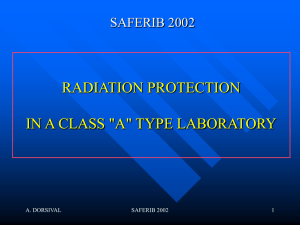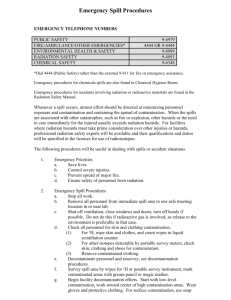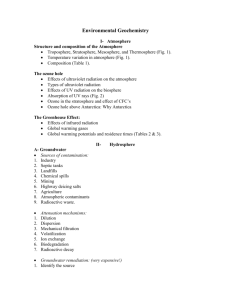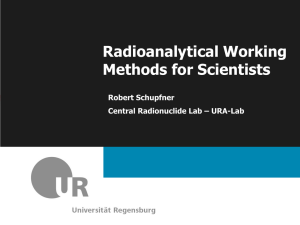Local Rules Template - Ionising Radiation
advertisement
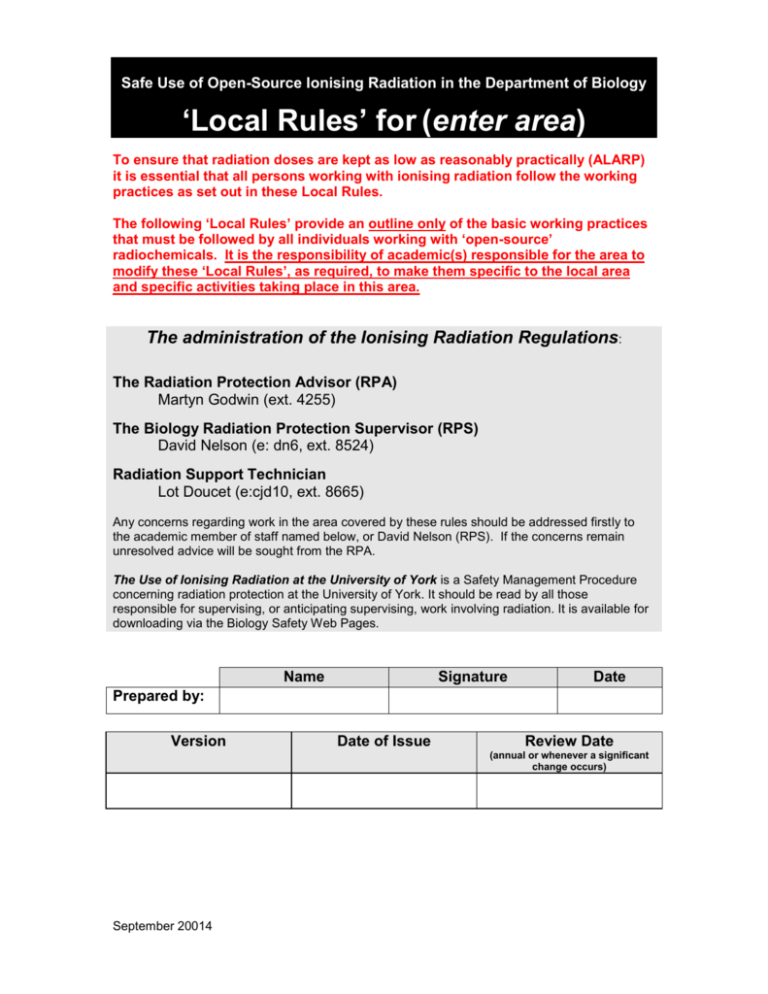
Safe Use of Open-Source Ionising Radiation in the Department of Biology ‘Local Rules’ for (enter area) To ensure that radiation doses are kept as low as reasonably practically (ALARP) it is essential that all persons working with ionising radiation follow the working practices as set out in these Local Rules. The following ‘Local Rules’ provide an outline only of the basic working practices that must be followed by all individuals working with ‘open-source’ radiochemicals. It is the responsibility of academic(s) responsible for the area to modify these ‘Local Rules’, as required, to make them specific to the local area and specific activities taking place in this area. The administration of the Ionising Radiation Regulations: The Radiation Protection Advisor (RPA) Martyn Godwin (ext. 4255) The Biology Radiation Protection Supervisor (RPS) David Nelson (e: dn6, ext. 8524) Radiation Support Technician Lot Doucet (e:cjd10, ext. 8665) Any concerns regarding work in the area covered by these rules should be addressed firstly to the academic member of staff named below, or David Nelson (RPS). If the concerns remain unresolved advice will be sought from the RPA. The Use of Ionising Radiation at the University of York is a Safety Management Procedure concerning radiation protection at the University of York. It should be read by all those responsible for supervising, or anticipating supervising, work involving radiation. It is available for downloading via the Biology Safety Web Pages. Name Signature Date Prepared by: Version Date of Issue Review Date (annual or whenever a significant change occurs) September 20014 1. These Local Rules Refer to Work Being Conducted in Room(s): Insert your room numbers here (use the full biology room number code as on the doors) Note: where work is undertaken within a delineated area within the room named, this area should also be described. This is particularly important for others who may be working in the lab but not with radioisotopes. 2. Designation of Laboratory Area The designation of the laboratory area used for ionising radiation is normally based on the results of risk assessments for activities being undertaken in the area. The definitions of controlled and supervised areas are available on the departmental safety pages at: http://www.york.ac.uk/depts/biol/web/safety/saf_rad.htm Note: all areas used for open-source work are normally designated as either ‘controlled’ or ‘supervised’ areas. The designation level dictates the restrictions on access and other conditions that are placed on these areas. Laboratory areas using low levels of open-source materials and standard good radiochemical practices are typically designated as supervised areas. However, the designation of an area should be constantly reviewed and revised if necessary, following consultation with the local RPS. The laboratory area used for ‘open-source’ radioisotope work has been designated a ‘SUPERVISED AREA’ / ‘CONTROLLED AREA’ (delete as appropriate) 3. The Following Radioisotopes will be used in this Area: List the isotopes to be used in the area under consideration. 4. Risk Assessments All new work involving radiation must have been notified to the RPS by means of the Prior Risk Assessment Form (available from the Biology safety Web pages) and approval must have been given before such work can begin. Risk assessments must be available for all ongoing work and academic(s) responsible for the area must make copies easily accessible to all those working in the area covered by the local rules. September 20014 The Main Activities Being Conducted in this Area are Covered by Risk Assessments: List the risk assessments (titles & codes (initials of supervisor followed by number)) which apply to this area. No. Title of Risk Assessments Group Leader & Code* *A risk assessment code is assigned to all risk assessments and is usually the Group Leader’s initials followed by a number 5. Safety Management (a) The academic member(s) of staff who assume overall responsibility for the safety management of work conducted in the area(s) listed above: Insert the names of academic members of staff supervising the work. (b) The local person(s) nominated to assist the RPS in overseeing that these local rules are followed: Enter the name of a local person who works in this area who will assist the RPS in checking that these rules are being followed. This person should report any concerns, incidents to the RPS. 6. Registered users of Radiation / Training Requirements & Records All users of ionising radiation in the local area must be registered and receive appropriate training. A list of these workers, together with details of training received must be included and updated, as and when required, in Appendix 2 at the end of these local rules. a) Formal Training All users must complete the formal on-line University of York radiation training before starting radiation activities. b) Local Practical ‘on the job’ Training All users MUST receive local training BEFORE starting ionising radiation work. Local training will include: instruction on all ‘Local Rules’ operating in the area risk assessments: information on the risks to workers and how these will be managed instruction and demonstration of specific experimental procedures as required 7. Working Practices for this Area are: September 20014 A list of generic working practices that apply to all areas using ‘open-source’ radioactive materials is provided below. These must be amended / supplemented where necessary to reflect the specific activities and practices operating in the local area. It is recommended that a description of safe working practices / procedures for specific experimental activities are attached as an Appendix to this document. Information should include specific guidance on how to conduct experiments safely e.g. “tubes to be removed with forceps behind the perspex screen and placed in the shielding vial before removal to the water bath…”) General, Good Working Practices for all radioisotope activities Laboratory coats must always be worn in rooms where radioactive materials are used. Gloves (two pairs recommended) must be worn during work activities involving all radioactive materials. Eating, drinking, smoking and applying cosmetics is not permitted in any laboratory area. Cuts or wounds must be covered with a waterproof dressing. Work in designated areas only. To reduce dose, use the minimum amount of radioactivity necessary for each experiment. Items of laboratory equipment in the designated laboratories should be especially reserved for use with radioactive materials, and should not be used for other purposes. All operations with radioactive materials should be carried out over a spill tray lined with absorbent paper. So far as is reasonably practicable, no unsealed radioactive substance or any article containing a radioactive substance should be held in the hand or directly manipulated by hand. Be prepared for accidents and follow the emergency spillage instructions (see details below). All materials such as gloves, absorbent paper, etc., which have been used with radioactive materials, should be treated as solid active waste, and be disposed of accordingly. Return radioactivity to the fridge / freezer as soon as possible and remember to complete stock record sheet appropriately. Wash and monitor the hands after handling radioactive materials and on leaving the laboratory. Pregnant workers should notify the DRPS, who will review the risk assessment for the work activities and decide if any restrictions are necessary. September 20014 Good working practices for work with 32P Instructions describing the safe working practices for specific experimental activities using 32-P in this area should be attached as an Appendix to this document. Always work behind 10 mm thick perspex shielding and over a lined spill tray. Always wear the dosimeter provided. It is advisable to wear a finger dosimeter when handling 32P, especially inexperienced users, and it is also advisable to wear one when handling stock levels of 33P. Reduce exposure to hands by avoiding direct contact with sample tubes wherever possible and using a plastic shield on the end of pipettes. Samples must be kept in shielded containers between and, wherever possible, during manipulations. Safety glasses should be used where required e.g. when manipulating unshielded samples and where body shielding does not shield eyes. Good working practices for work with 35S Instructions describing the safe working practices for specific experimental activities using 35-S in this area should be attached as an Appendix to this document. Since 35S is a ‘softer’ beta emitter than 32P use of perspex shielding is recommended only when working with high activity stock solutions. To reduce contamination with 35S volatiles, use a fume hood when handling stock volumes. Incubators used for cell labelling must contain activated charcoal filters to absorb volatile impurities produced. Periodically check storage areas (fridges, freezers) for contamination with 35S volatiles. Good working practices for work with 3H Instructions describing the safe working practices for specific experimental activities using 3-H in this area should be attached as an Appendix to this document. Since tritium presents a negligible external radiation hazard the use of protective shielding is unnecessary and manipulations can take place within a labelled worktray on the laboratory bench. Since tritium can be absorbed through the skin workers should wear two pairs of disposable gloves. Fume hoods should be used to handle volatile materials such as tritiated water. Since monitoring of skin for 3H contamination is difficult, hands must be washed thoroughly following all work with this 3H material. 3H may be monitored by scintillation counting of wipe test swabs (see Appendix 1 for details). Storage areas should be periodically checked for tritiated water vapour released from containers as a result of radiolysis. September 20014 Good working practices for work with 14C Instructions describing the safe working practices for specific experimental activities using 14-C in this area should be attached as an Appendix to this document. Since 14C presents a negligible external radiation hazard the use of protective shielding is unnecessary and manipulations can normally take place within a labelled worktray on the laboratory bench. 8. Contamination Monitoring It is the responsibility of every worker to monitor their working area and leave it in a clean and safe condition after working with radioactive material. Monitor work area and any equipment before commencing work to ensure that counts are no higher than background. After completion of work with radioactive materials monitor the work area and equipment used and record this information on the contamination check record form provided. These checks are important to identify areas that could have become accidentally contaminated, and ensure these are free of contamination before the next user of the facility. Contamination checks on completion of experiment work should include: work surfaces and flooring equipment used including pipettes designated disposal sinks you! periodic checks of storages areas (typically fridges and freezers) Work areas, equipment, fridges and freezers should be monitored for contamination on a regular basis. An appropriate contamination monitor must be selected for the radioisotopes being used in the local area, and this must have been calibrated within the last 12 months. For the Mini Monitor range of equipment probe type EL or EP15 is suitable for 14C, 35S or 33P in addition to 32P. Since conventional contamination monitors are not sensitive enough to detect the low energy isotope tritium (3H), periodic ‘wipe-tests’, requiring the use of a scintillation counter, must be performed (see outline of procedure in Appendix 1). ‘Wipe tests’ should be performed monthly, or once a series of experiments using tritium is complete (whichever comes sooner). The departmental Radiation Support Technician (Lot Doucet) will also conduct regular monitoring (every two months) of contamination to supplement the routine monitoring performed by those working in the area. Check the status of the contamination monitor’s battery before use by turning the control knob to ‘bat’- if the needle does not remain in the green region of the scale the batteries must be replaced. September 20014 Monitoring should be carried out slowly and methodically with the probe held about 1 cm from the surface being checked for contamination. 9. Dealing with Spillages General Procedure applicable to all spills DO NOT PANIC- remain calm and minimise the spread of contamination Give priority to any persons involved rather than surfaces or equipment Warn other personnel in the vicinity of the incident and ensure that they keep away from the contaminated area Report the accident / incident by completing the ‘Health & Safety Report Form’, available in all laboratory areas. If personal contamination occurs or the spillage is significant (> 10 MBq) contact the departmental RPS (David Nelson, ext. 8524) or RPO (Martyn Godwin, ext 4255). Personal contamination (skin or clothes) Identify the persons involved Anyone assisting should wear gloves and laboratory coat to prevent the themselves becoming contaminated Monitor with a counter to assess the extent of contamination Contaminated clothing should be removed carefully and placed in a black bin liner. The bag should be sealed with radioactive tape and labelled with date, isotope and count/second. Follow procedures for either disposal or storage of radioactive waste. Monitor remaining clothing and any exposed skin If contamination has penetrated clothing and reached skin, the affected area must be washed thoroughly and monitored. Skin must not be rubbed vigorously or it may become damaged allowing radioactive material to enter The following can be used for removing contamination from skin: 10% Lipcol in distilled water 5% Decon in distilled water soap and luke-warm water Gentle brushing e.g. with a nail brush can be used to remove any residual contamination, although take care not to break the skin surface. Contamination eyes should be well irrigated with eye wash bottle or other irrigation device. Dosemeters (whole body or extremity) worn by the worker affected by the contamination should be passed to the RPS. Dosemeters can be sent away for emergency response measurement so that the dose of the radiation received can be quantified. September 20014 Spillages on work areas and floors Monitor the area and assess the extent of contamination For high energy isotopes (e.g. 32P) appropriate shielding must be used whilst affecting decontamination. Close off area and erect warning signs wherever possible Clean up any liquid spillage immediately. Start from outer edge of spill and work inwards with thorough monitoring at each stage. Swab using paper tissues which are disposed of in a radioactive solid waste bin (shielded if necessary). Use long forceps to maximise distance, reducing exposure for high energy isotopes such as 32P. Clean the area with either: 5% solution of Decon ‘Count-off’ aerosol spray 10% solution of Lipcol Monitor and repeat until contamination is significantly reduced, preferably to background levels If contamination persists, consider covering with appropriate shielding and using warning signs, or preventing access to room. Place any stock containers or samples into shielded pots and after decontamination and monitoring, remove from the affected area Decontamination of equipment When purchasing equipment for radioactive use consider carefully whether decontamination procedures will damage mechanics or not Always switch off equipment from mains and unplug from socket before beginning any decontamination procedures Pipetting devices e.g. Pipettes may be decontaminated by dismantling and sonicating components in a solution of 5% Decon or 10% Lipcol If decontamination is not possible then clearly label item and store in a suitable area until activity is sufficiently reduced that the article may be returned to its original use (applicable to short half-life radioisotopes) 10. Ordering / Purchase of Radioisotopes Radioisotopes can only be ordered for approved work activities. All radioisotopes must be ordered by authorised persons only. This will include all supervisors and other persons as nominated by the supervisor if required. Ordering using York E-Purchasing (YEP): authorised persons must select the ‘Radiochemicals' product code when placing an order for radiochemicals. September 20014 11. Receipt and Storage of Radioisotopes Each item ordered will be given a stock card on arrival and the user is responsible for keeping track of the usage, storage and disposal of the material. The stock card must be kept-up-to-date and available for inspection during Safety Audits. On receipt of stock isotopes, check that the details on the record sheet match those on the container. The contents of radioactive packages from suppliers should be treated as if they were contaminated. Unpack carefully and monitor the packaging. The ‘W-Number’ is a unique number given to all stocks of ‘open-source’ radioactive materials brought into the department. To help easily identify each stock item the stock container must be labelled with this number. Biology Stores will label the containers of all stocks with this unique ‘WNumber before collection, apart from those materials that are transported on dry-ice. For these materials, it is the responsibility of the person who placed the order to ensure that the label, provided by Biology Stores, is added to stock container when the stock is unpacked. Alternatively, the container can be labelled with a black marker pen if the label won’t stick to the container. Radioisotope stocks should be kept in a lockable container. Dispensed stocks should be kept in proper sealed containers, correctly labelled and securely stored. There is no need to use radioactive hazard warning stickers on containers holding small amounts of low energy (C-14, H-3) isotopes. If the containers holds less than 0. 1 MBq do not label it with the radiation hazard warning sign. Likewise refrigerators or other areas need not be labelled with radioactive warning signs if the amounts contained are less than 1MBq. When stock materials are finished, or have decayed such that there is no longer any radioactive material present, stock cards should be completed and returned to the Radiation Support Technician (Lot Doucet), FO. 12. Waste Disposal Instructions for this Area (consider liquid waste to drains, solid waste and organic waste) are: The following forms record the use and disposal of radiochemicals: stock records cards: used to record and monitor the use of all stock materials aqueous waste disposal forms: used to record the monthly disposal of material down the designated sink solid waste disposal forms: used for the disposal of very low level waste to outside refuse bins collected by local authority organic scintillant waste disposal forms: used to record disposal of all scintillant waste collected by a contractor Specific instructions for disposal of radioactive waste in this area include: September 20014 Solid Waste General All radioactive signs must be removed from waste materials before disposal Issues concerning solid waste disposal from an area should be discussed with the Radiation Support Technician (Lot Doucet) before new work begins. All materials such as gloves, absorbent paper, etc., which have been used with radioactive materials, should be treated as solid active waste, and be disposed of accordingly. 35S, 32P Waste All solid waste must be placed in bags located in a labelled, lidded Perspex storage container. Contents of the storage containers should be transferred to the departmental solid radioactive waste storage sheds (between Blocks D and F). A key for this area is available from XXX. Disposal forms kept in the sheds must be completed as instructed. Record any solid waste disposal on the appropriate stock record sheet. Very Low Level Solid Waste (typically used for 14C, 3H, 45Ca) The maximum amount of radioactive waste in any single bag (up to a volume of a typical black bin bag) should not contain more than: o o <4000 kBq (14C, 3H only) <400 kBq for other isotopes No single item within the bag should exceed: o 400 kBq (14C, 3H only) o 40 kBq for other isotopes VERY LOW LEVEL WASTE MUST NOT BE STORED FOR MORE THAN 6 WEEKS BEFORE DISPOSAL IN TO THE LARGE GENERAL REFUSE BINS LOCATED OUTSIDE THE DEPARTMENT Waste can be stored in the lab. facility but MUST be disposed of within a 6 week period. To ensure waste is not left longer than 6 weeks, workers should empty their waste bin into a black bin liner at the end of each experimental activity, before taking it to the large general refuse collection bins outside the department (located near the Biology Stores Compound Area) for collection by the local authority. All signs indicating the presence of radioactive materials must be removed before disposal to avoid raising unnecessary concern. These disposals must be recorded on the ‘solid waste disposal form’ for very low level waste put in refuse bins and collected by the local authority. September 20014 Liquid Waste Use only the designated sink provided for the disposal of all aqueous waste material. This sink has monthly disposal limits for specific isotopes used in the laboratory (see notice above sink for these limits) which must not be exceeded. If waste exceeds allowable disposal limit for the month hold contact the Radiation Protection Supervisor (RPS), David Nelson, immediately. Carefully dispose of liquid waste down the sink before flushing the sink with copious amounts of water. Record all disposals on the yellow aqueous disposal record sheet. At the end of each month the sink disposal sheets will be collected by Lot Doucet (Radiation Support Technician). Liquid Organic (Scintillant) Waste The red organic ‘scintillant’ waste bin is used for the disposal of all scintillant waste. Record all disposals on the yellow organic liquid ‘scintillant’ disposal sheet, making sure that the limits are not exceeded. Contact Lot Doucet (Radiation Support Technician) when the bin requires collection for safe storage. 13. Restriction of Access: Precautions for Non-Radiation Workers Access to facilities used for radiation activities is normally restricted to those workers who are registered to work with radioactive materials. However, other workers, such as maintenance staff, service engineers or cleaners, may also need occasional access to the facilities. Local approval is required before these non-radiation workers are allowed to enter or work in the radiation facilities. Individuals must be made aware of the radiation hazard and any restrictions or precautions that must be taken whilst working in the area. 14. Loss of Open Source Material If loss of open source material is suspected an initial check of obvious areas should be undertaken. If loss is still suspected following preliminary checks, this must be must be reported immediately to the RPS (Biology) and the University RPO. 15. Sources of Further Information Include: Biology Safety Information pages September 20014 University Health, Safety and Welfare Department September 20014 APPENDIX 1: ‘Wipe Test’ Procedure to Monitor for Tritium Surface Contamination Wipe tests are performed by wiping the areas of interest with a filter paper disk and then determining the activity in a counter calibrated for the suspected radionuclide. It is usually assumed that only 10% of any removable activity is actually transferred to the wipe and that the area wiped is, typically, 100 cm2. Wipe tests are more sensitive than instrument surveys and are the only practicable method of monitoring for tritium (3H), a weakly-penetrating beta emitter. 1. Moisten a suitable wipe, such as a glass-fibre disc small enough to fit into a liquid scintillation vial, with water or other solvent in which the contamination is soluble. (Glass fibre is preferable to paper as it is wetted more effectively by the liquid scintillant and produces a higher counting efficiency - important when detecting 3H. Some commercial wipes are made of materials such as polystyrene which dissolve in scintillation fluid and enable efficiency to be determined by the usual methods. 2. Wipe a known area of surface, normally 100 or 1000 cm2. 3. Place the wipe into a scintillation vial with 10 cm3 of liquid scintillant. 4. Count the activity in a liquid scintillation counter. 5. In the absence of any more accurate information assume that 10% of the activity on the wiped surface has been transferred to the wipe. 6. Calculate the contamination level (contamination level = Bq cm -2) The following information is required to calculate the contamination level: a) count-rate in cps, corrected for background b) A = area wiped in cm2 c) Eff = percentage counting efficiency for isotope in question d) T = percentage of contamination picked up (normally 10%) Example: An area of 1000 cm2, contaminated with tritium, is wiped. The wipe is counted in a liquid scintillation counter which has an efficiency of 30%. A count-rate of 9000 cps is obtained, The contamination level is 300 Bq cm-2. September 20014 APPENDIX 2 Registered Users of Radiation / Training Requirements & Records All users MUST be registered to use ionising radiation and receive local training BEFORE starting ionising radiation work. This training must be provided by the RPS & Group Leader (or other competent person nominated by the Group Leader). Users must also complete University of York on-line radiation training before starting radiation work. Local Training must include the following elements: 1. Instruction on all ‘Local Rules’ operating in the area, including: Designated Radioactive Work Areas the areas of the laboratory that are designated radiation work areas Ordering & Receipt procedure for ordering and receipt of radioactive materials safe opening of radioactive packages Storage safe storage arrangements for radioactive materials Dose Reduction Measures measures taken to avoid spread of contamination and reduce risk of exposure as low as possible Waste Disposal disposal of liquid (aqueous & scintillant) and solid waste materials (including completion of associated disposal forms) completion of stock record cards Spillage emergency spillage procedure Monitoring contamination check procedure, including use of contamination monitor and how to ‘wipe-test’ for 3H, if relevant use of body and finger dosemeter badges if relevant Hazard Warning Signs labelling storage areas where radioactive materials are held labelling samples and of equipment used for radioactive materials September 20014 2. Risk assessment: all workers to be made aware of the significant findings of relevant risk assessment(s) (including dose assessment) and specific measures that have been identified to reduce exposure as low as possible 3. Instruction and demonstration of handling techniques and specific experimental procedures: the level of detail will depend on previous knowledge and experience of the individual. It is the responsibility of the supervisor to provide or arrange close supervision for those with little or no previous experience working with radiochemicals, until competence to work independently has been achieved. September 20014 APPENDIX 2 Registered Users of Radiation / Local Training Records The following represents a list of all workers using ionising radiation in this area: Names Radioisotopes they may use Radiation badge needed? (required for 32P users) Yes/ No Training Received Completed UoY on-line training?: Yes / No Local Practical Training Signature Trainer Trainee Note: List must be kept up-to-date and available for inspection September 20014 Date
